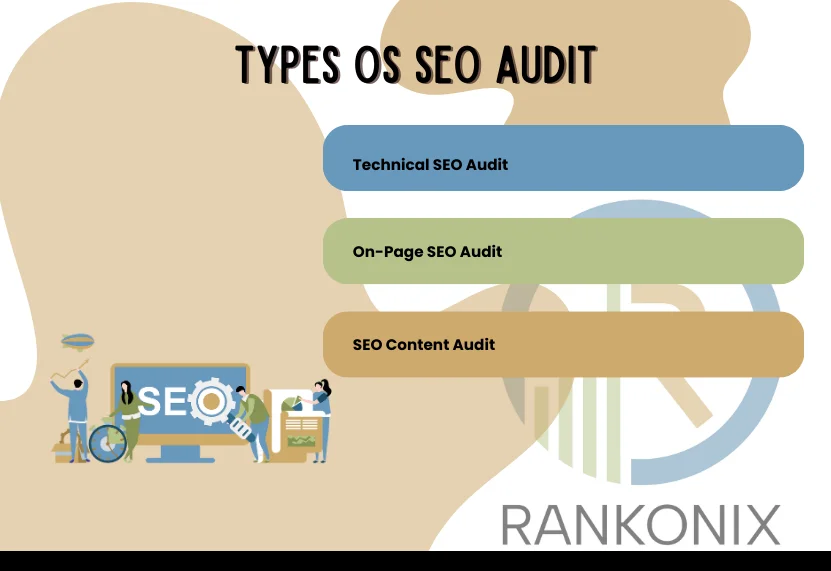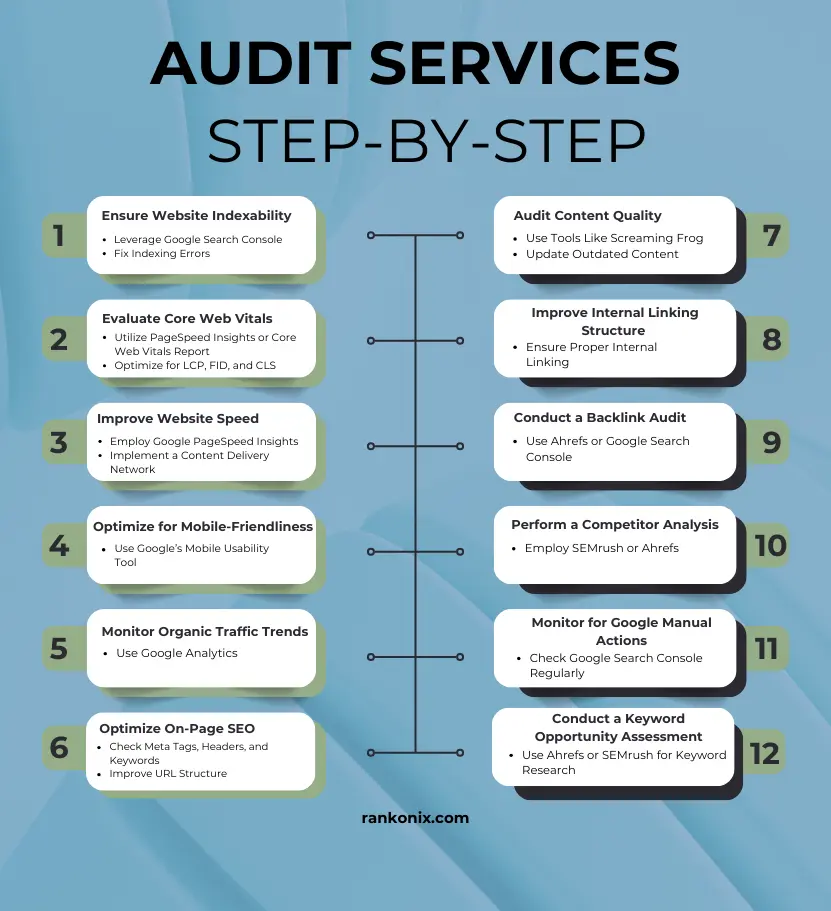In today’s competitive digital world, maintaining high search engine visibility is crucial for any website looking to succeed. This is where an SEO audit comes into play. It is an essential step to boost and maintain your website’s performance and visibility, ensuring it stays competitive in the crowded online space. So, why are SEO audit services so important, and how can you conduct one effectively?
In this comprehensive guide, we will explore what an SEO audit involves, why it is necessary, and provide a detailed, step-by-step process for conducting one using top SEO tools. If your goals include optimizing your site, improving user experience, and outperforming your competitors, this guide is for you.
Table of Content
What Is an SEO Audit?

An SEO audit is a thorough evaluation of your website to ensure it is optimized for higher search engine rankings, particularly on Google. It involves analyzing various key elements such as website structure, technical setup, content quality, keyword strategy, and overall user experience. The main goal of SEO audit services is to identify and fix issues that might hinder your site’s ranking, thereby improving its visibility and boosting traffic.
Audit SEO google are invaluable because they provide insights into your website’s performance on search engines and pinpoint specific areas for improvement. Without regular audits, opportunities to increase traffic, improve rankings, and enhance conversions might be missed, giving your competitors an edge.
The Significance of SEO Audit Services
It is crucial for several compelling reasons:
- Improved Website Performance: Regular audits ensure your site loads quickly, offers a great user experience and is easy to navigate. These improvements not only enhance search engine rankings but also increase visitor satisfaction.
- Adaptation to Search Engine Updates: Search engines, like Google, often update their algorithms, and audits help you adapt to these changes, maintaining or even improving your site’s search result positions.
- Increased Organic Traffic: By addressing issues found in an SEO audit, you can significantly boost your organic search traffic, attracting more potential customers to your site naturally.
- Higher Conversion Rates: A well-optimized website that provides a seamless user experience increases the likelihood of converting visitors into customers, leading to higher conversion rates and sales.
With the importance of an SEO audit established, let’s dive into the different types of SEO audit services—technical, on-page, and off-page—and see how each contributes to your website’s overall success and performance.
Types of SEO Audit Services

There are several types of SEO audits, each focusing on a different aspect of your website:
1. Technical SEO Audit
A technical SEO audit assesses the technical aspects of your website, such as how well search engines can crawl and index it. It includes analyzing your site’s structure, speed, mobile-friendliness, and ensuring there are no issues blocking search engines from accessing your content.
2. On-Page SEO Audit
An on-page SEO audit evaluates elements like meta tags, headers, keywords, and URL structures. It ensures that your website pages are optimized for specific keywords and that the content is structured in a way that both search engines and users can easily understand.
3. SEO Content Audit
An SEO content audit involves reviewing your website’s content to ensure it’s relevant, well-written, and optimized for search engines. It helps identify thin or outdated content that needs refreshing or removal and ensures your content provides value to users.
Conducting a thorough audit SEO Google approach will enhance your site’s performance and keep you ahead in the search results.
SEO Audit Checklist
- Ensure indexability by checking for crawl and index errors in Google Search Console.
- Review Core Web Vitals using tools like Google Lighthouse to enhance user experience.
- Analyze page speed through PageSpeed Insights and improve load times for better performance.
- Verify mobile-friendliness with Google’s Mobile-Friendly Test and optimize for mobile users.
- Check organic traffic trends in Google Analytics and assess growth or drops in traffic.
- Review on-page SEO, optimizing title tags, meta descriptions, and headers with relevant keywords.
- Audit content for quality, relevance, and keyword optimization to ensure SEO content audit success.
- Optimize internal linking structure to improve user navigation and SEO rankings.
- Perform a backlink audit using tools like Ahrefs to disavow toxic links and build domain authority.
- Conduct competitor analysis to identify SEO opportunities by comparing strategies.
- Review any manual actions or penalties in Google Search Console and resolve them promptly.
- Conduct a keyword opportunity assessment to identify and target valuable keywords for ranking improvement.
This checklist provides a streamlined approach to conducting an effective SEO audit.
Step-by-Step Audit Services Guide: Boost Your Website’s Rankings

Discover how to perform an SEO audit to enhance your website’s performance and visibility. Follow this SEO audit checklist to identify and fix issues, improve your site’s search engine rankings, and enhance user experience. Let’s dive in!
Step 1: Ensure Website Indexability
First, confirm that your website is crawlable and indexable by search engines like Google and Bing. This step is crucial for your content to appear in search results during a technical SEO audit.
- Leverage Google Search Console: This tool provides valuable insights into how Google indexes your site. Check the “Coverage” report for issues like “noindex” tags or broken links that could hinder search engine crawling. Address any warnings or errors as part of your SEO audit.
- Fix Indexing Errors: Resolve issues such as 404 errors, server problems, or blocked pages that might prevent search engines from accessing your content. After resolving errors, submit an updated sitemap to help search engines re-crawl your site efficiently during the technical SEO audit.
Step 2: Evaluate Core Web Vitals
Core Web Vitals are key metrics used by Google to assess user experience, focusing on loading speed, interactivity, and visual stability. This is a crucial part of a technical SEO audit.
- Utilize PageSpeed Insights or Core Web Vitals Report: These tools offer insights into your website’s performance, speed, and stability, providing actionable recommendations for improvement.
- Optimize for LCP, FID, and CLS: Aim for Largest Contentful Paint (LCP) under 2.5 seconds, First Input Delay (FID) under 100 milliseconds, and minimal Cumulative Layout Shift (CLS) to enhance user satisfaction.
Step 3: Improve Website Speed
Website speed is essential for SEO and user experience. Faster sites tend to rank higher and provide a better visitor experience. A technical SEO audit should always include an assessment of site speed.
- Employ Google PageSpeed Insights: Analyze load times, focusing on reducing image sizes, enabling browser caching, and minimizing CSS and JavaScript files. Implement lazy loading for images to enhance loading performance.
- Implement a Content Delivery Network (CDN): Use a CDN to improve load times by caching your site’s content across multiple global locations, ensuring faster content delivery to users and reducing server load.
Step 4: Optimize for Mobile-Friendliness
With more than half of web traffic from mobile devices, ensuring your website is mobile-friendly is crucial for audience engagement and an effective technical SEO audit.
- Use Google’s Mobile Usability Tool: This tool checks your website’s mobile performance, identifying issues like unreadable text, closely packed clickable elements, and responsiveness problems that affect the mobile user experience, all essential elements of a technical SEO audit.
Step 5: Monitor Organic Traffic Trends
Tracking your website’s organic traffic is essential for understanding user engagement and improving content.
- Use Google Analytics: Regularly analyze organic traffic trends over the past 6-12 months to spot patterns, like seasonal changes or dips, indicating shifts in user interest or areas needing improvement.
Step 6: Optimize On-Page SEO
On-page SEO is essential for boosting search engine rankings and enhancing user experience.
- Check Meta Tags, Headers, and Keywords: Ensure each page has unique, compelling title tags and meta descriptions with target keywords to improve search engine rankings and increase click-through rates with an effective on-page SEO audit.
- Improve URL Structure: Create concise, keyword-rich URLs that are easy to understand, helping search engines and improving click-through rates as part of a comprehensive on-page SEO audit.
Step 7: Audit Content Quality
High-quality, relevant, and engaging content is the key to website success.
- Use Tools Like Screaming Frog: These tools identify thin or duplicate content that can harm search rankings. Ensure content is valuable and keeps user interest for an effective SEO content audit.
- Update Outdated Content: Regularly refresh old content to keep it relevant, reflecting the latest industry trends and information, crucial for a successful SEO content audit.
Step 8: Improve Internal Linking Structure
Internal linking is important for distributing link equity and improving site navigation, enhancing both user experience and search engine rankings.
- Ensure Proper Internal Linking: Key pages should be appropriately linked throughout your site. Use descriptive anchor text to provide clear navigation paths for users and help search engines understand page context and significance.
Step 9: Conduct a Backlink Audit for SEO Success
Backlinks are crucial for search engine optimization, serving as endorsements that boost your site’s authority and credibility.
- Use Ahrefs or Google Search Console: Regularly evaluate your backlink profile with tools like Ahrefs or Google Search Console to maintain optimal performance. These platforms help you find high-quality links that improve your site’s reputation and allow you to detect and disavow harmful links that could damage your site’s authority and rankings. Conducting routine backlink audits is essential for consistently attracting valuable links.
Step 10: Perform a Competitor Analysis to Enhance Your SEO Strategy
Competitor analysis provides strategic insights that can refine your SEO strategy. Understanding competitors’ successful tactics helps identify growth opportunities.
- Employ SEMrush or Ahrefs: Use these tools for a detailed view of competitors’ SEO strategies. Examine their ranking keywords, content strategy, and market capture methods. By assessing their strengths and weaknesses, you can find opportunities to outpace them and capture a larger audience share.
Step 11: Monitor for Google Manual Actions
Manual penalties from Google can result in significant ranking and visibility declines if your site violates its guidelines.
- Check Google Search Console Regularly: Frequently check your Google Search Console for manual actions or penalties, and address issues quickly to restore your site’s ranking. This may involve removing problematic content or revising SEO practices to align with Google’s standards.
Step 12: Conduct a Keyword Opportunity Assessment for SEO Growth
Finding new keyword opportunities is vital for staying competitive. Targeting the right keywords helps attract a more relevant audience.
- Use Ahrefs or SEMrush for Keyword Research: These tools help identify keyword gaps and new long-tail keywords to target. Long-tail keywords, being more specific and less competitive, often result in higher conversion rates as they match specific search intents. This assessment refines your content strategy to better meet user needs.
The Importance of Professional SEO Audits by Rankonix
Conducting an SEO audit can be complex and time-consuming, especially if you’re unfamiliar with the technical aspects involved. At Rankonix, we offer expert SEO audit services to identify and resolve issues hindering your site’s performance. Our thorough audits cover all SEO aspects, from technical parameters to content quality and backlink integrity, ensuring your website runs at peak performance.
We utilize the leading SEO audit tools, including Google Search Console, Ahrefs, and Screaming Frog, to provide actionable insights that enhance your website’s visibility. Our audits deliver strategic improvements that drive more traffic and engagement.
Contact us at Rankonix for a professional SEO audit service to help you surpass competitors and boost your site’s traffic, enhancing your online presence and achieving your business goals.
Conclusion
An SEO audit is fundamental for boosting your website’s performance and maintaining a competitive advantage in the digital marketplace. By following this comprehensive, step-by-step guide and using top-tier SEO audit tools, you can ensure your website is fully optimized for search engines and offers an excellent user experience.
For businesses looking to improve SEO without handling complex audits, Rankonix provides thorough technical SEO audit services. Our expertise helps pinpoint and correct any issues, ensuring your website realizes its full potential. Contact us today to elevate your SEO strategy and increase your site’s visibility.
FAQs
Q. What is an SEO audit?
An SEO audit is a detailed evaluation of your website’s search engine optimization. It analyzes technical SEO, on-page elements, content quality, backlinks, and user experience to highlight areas for improvement and ensure alignment with search engine guidelines.
Q. How often should you conduct an SEO audit?
Perform audits at least once or twice a year. If your website undergoes major changes, sees a drop in performance, or competes in a highly competitive market, consider increasing the frequency of your audits. Opt for quarterly, monthly, or even weekly checks to maintain top site performance and improve search engine rankings.
Q. Can you perform an SEO audit yourself, or should you hire a professional?
You can conduct a basic SEO audit using online tools, but hiring a professional ensures a comprehensive analysis. Experts can identify subtle issues and provide strategies that enhance your site’s visibility and search engine rankings.
Q. What are the key tools for an SEO audit?
Popular tools for SEO audits include Google Search Console, Ahrefs, Screaming Frog, and SEMrush. These tools assess keyword performance, technical issues, content quality, and backlink health.










[…] The Technical SEO Audit Process […]
[…] Conducting a site audit is crucial for identifying and fixing SEO issues that can affect your websit…. From technical glitches to on-page SEO tweaks, an audit is your secret weapon for better performance and higher rankings. […]